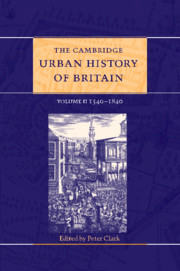Book contents
- Frontmatter
- 1 Introduction
- Part I Area surveys 1540–1840
- Part II Urban themes and types 1540–1700
- 5 Towns in an agrarian economy 1540–1700
- 6 Population and disease, estrangement and belonging 1540–1700
- 7 Politics and government 1540–1700
- 8 Reformation and culture 1540–1700
- 9 The urban landscape 1540–1700
- 10 London 1540–1700
- 11 Great and good towns 1540–1700
- 12 Ports 1540–1700
- 13 Small market towns 1540–1700
- Part III Urban themes and types 1700–1840
- Select Bibliography
- Index
- References
6 - Population and disease, estrangement and belonging 1540–1700
from Part II - Urban themes and types 1540–1700
Published online by Cambridge University Press: 28 March 2008
- Frontmatter
- 1 Introduction
- Part I Area surveys 1540–1840
- Part II Urban themes and types 1540–1700
- 5 Towns in an agrarian economy 1540–1700
- 6 Population and disease, estrangement and belonging 1540–1700
- 7 Politics and government 1540–1700
- 8 Reformation and culture 1540–1700
- 9 The urban landscape 1540–1700
- 10 London 1540–1700
- 11 Great and good towns 1540–1700
- 12 Ports 1540–1700
- 13 Small market towns 1540–1700
- Part III Urban themes and types 1700–1840
- Select Bibliography
- Index
- References
Summary
were the sixteenth and seventeenth centuries the first to define, for British people, ‘the urban experience’? In broad terms, the answer to this would have to be in the negative, since the pattern of major towns, at least in England and Scotland, was already long-established, and the sixteenth century’s increase in population can be seen as a phase of recovery as much as of expansion. On the other hand, it is in this period that London emerges as a European metropolis and as England’s capital city, that urbanisation becomes linked with national identity and centralised government, and that the proportion of those resident in towns, or sharing in the experience of towns in some phase of life, begins to accelerate. In this chapter, urbanisation will first be examined in demographic terms, with reference to migration, fertility, marriage and mortality, especially in relation to subsistence and the shift from epidemic to endemic causes of death. The second section explores contemporary sensibilities and social structure as affected by changes in the pattern of disease and in the urban environment, touching on gender, work and poverty, and contemporary ideas about population, crowding and urban life. By ‘environment’ we mean, in particular, factors affecting townspeople’s sense of the presence of others. The final section analyses the ambivalent character of two staple sources of reassurance, household and neighbourhood, which provided continuity but which can be shown to be open to challenge and renegotiation from within and without as urban pressures intensified.
- Type
- Chapter
- Information
- The Cambridge Urban History of Britain , pp. 195 - 234Publisher: Cambridge University PressPrint publication year: 2000
References
- 5
- Cited by

